The Basilica of San Clemente is a remarkable monument in the already extraordinary city of Rome. It’s a must-visit for anyone fascinated by the city’s layers of history.
San Clemente is an early 12th century church, built atop a 4th century church, which was built atop an ancient Imperial residence. It’s a collage of different architectural styles.
In this guide, I’ll tell you everything to see at the basilica, from golden mosaics to medieval frescos to ancient Roman ruins.
Tickets & Tours For San Clemente
It’s 10 euros to book a ticket online and 12 euros to purchase one onsite. What I did was to buy when on my phone when I arrived.
Because this is such a historic site, you might consider booking a guided tour. There is signage, but you’ll get more out of the experience with a guide.
You can book a 1 hour small group tour or a a 2.5 hour private tour.
You can also book a 2 hour guided tour that includes both San Clemente and St. Peter in Chains. The latter church is where you’ll find Michelangelo’s famous Moses sculpture.
Guide To Basilica of San Clemente: What To See
Inside San Clemente, you’ll find frescos and mosaics in the new church, a 1st century residence, a secret 3rd century pagan temple, and the Cloaca Maxima (the sewer system of ancient Rome).
Don’t be deceived by what appears to be the gated doorway to San Clemente. The visitor entrance is actually on the side of the building. It’s beneath an ornate Baroque portal.
Here’s what you can’t miss at San Clemente:
1. Interior Design
The nave is designed on a basilica plan. The word “basilica” refers to a long rectangular building with an apse or niche at one end. It’s an architectural form borrowed from ancient Rome and widely used for Christian churches in the West.
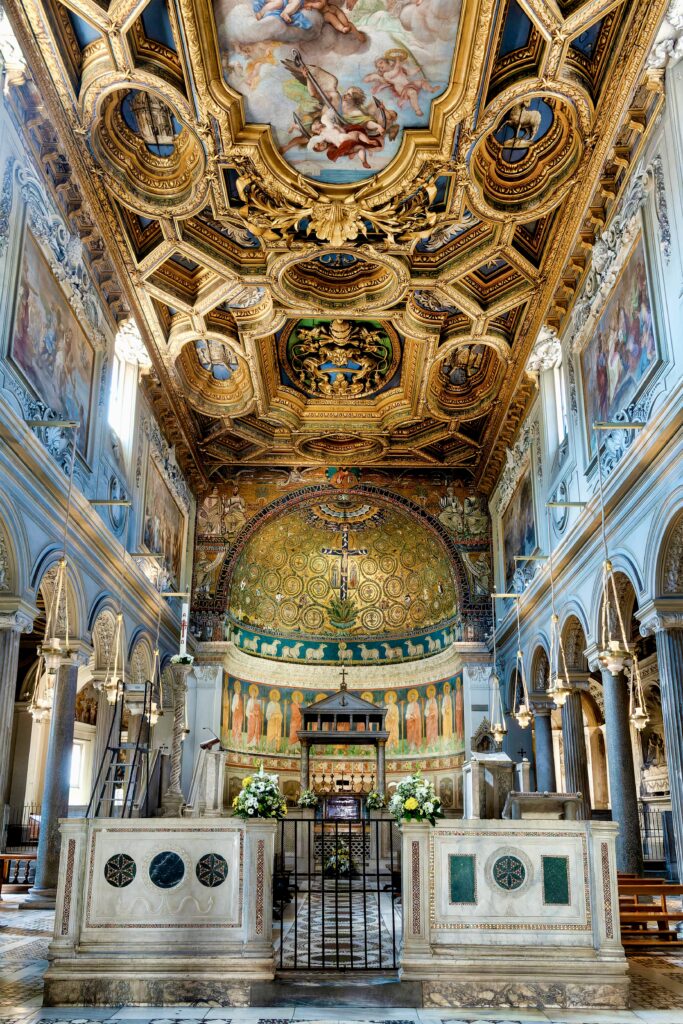
There are two side aisles, separated from the nave by an Ionic colonnade.
In the middle is a rectangular structure that serves as the choir, called the scuola catorum. The choir is decorated with polychrome marble panels bearing early Christian symbols.
2. High Altar
The high altar is surmounted by a rather diminutive or primitive baldachin, especially compared to Bernini’s baldachin at St. Peter’s Basilica.
The baldachin marks the grave of Saint Clement. He was the third successor to Saint Peter. He was one of the earliest popes, reigning during the last decade of the 1st century.
3. Apse Mosaics
The superb decoration in the apse is original, dating from the 12th century. The sparkling mosaics on a field of gold aren’t early Christian. Though they sure look like they are. They were influenced by the mosaics of the town of Ravenna.
There is a strikingly beautiful image of of the crucifixion. It’s unusual in that you have to look hard to see the body of Christ. Doves surround Christ. Below him are the Virgin Mary and John the Baptist.
The cross is rooted in an acanthus plant, which spirals into whorls. A vine is an important symbol in Christianity.
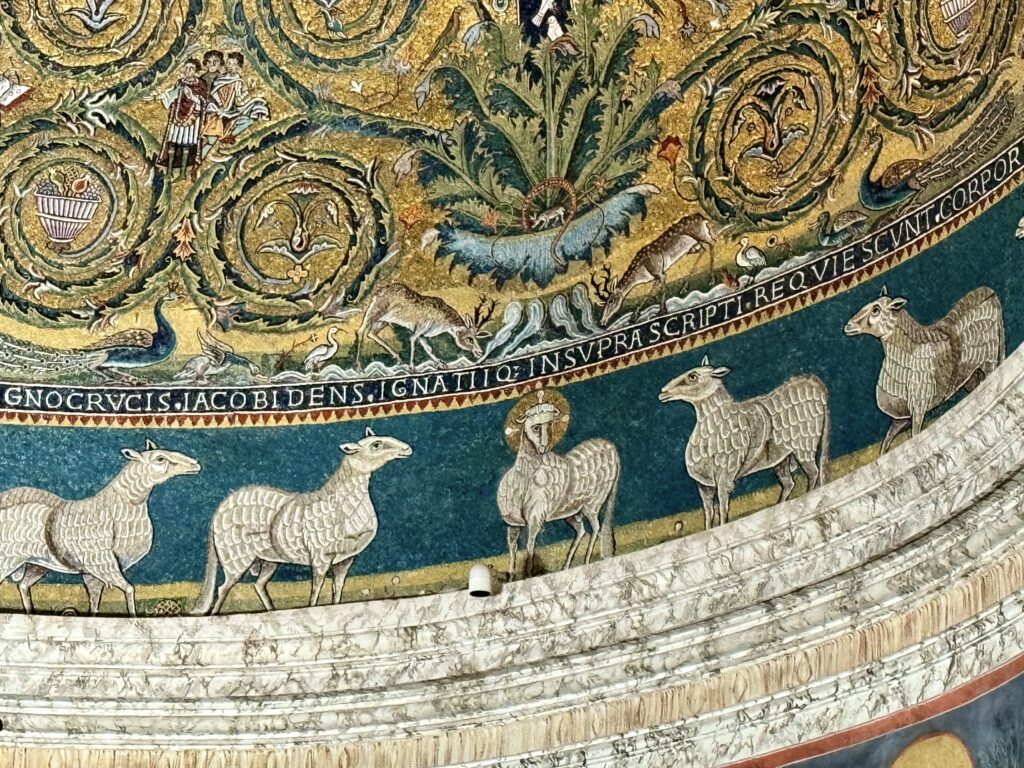
It represents eternal life and spreads out, akin to the apostles spreading Christianity. The acanthus is actually a re-use of an ancient Roman symbol.
There’s a lot going on in this mosaic scene. A deer drinks from a stream. There’s a lamb with a halo.
The sheep at the bottom represent the 12 apostles. Saints line the dome. Naked winged cherubs ride dolphins or play instruments.
There are some gentlemen in black and white tunics. They are the four original doctors of the Latin church: Augustine, Jerome, Gregory the Great and Ambrose.
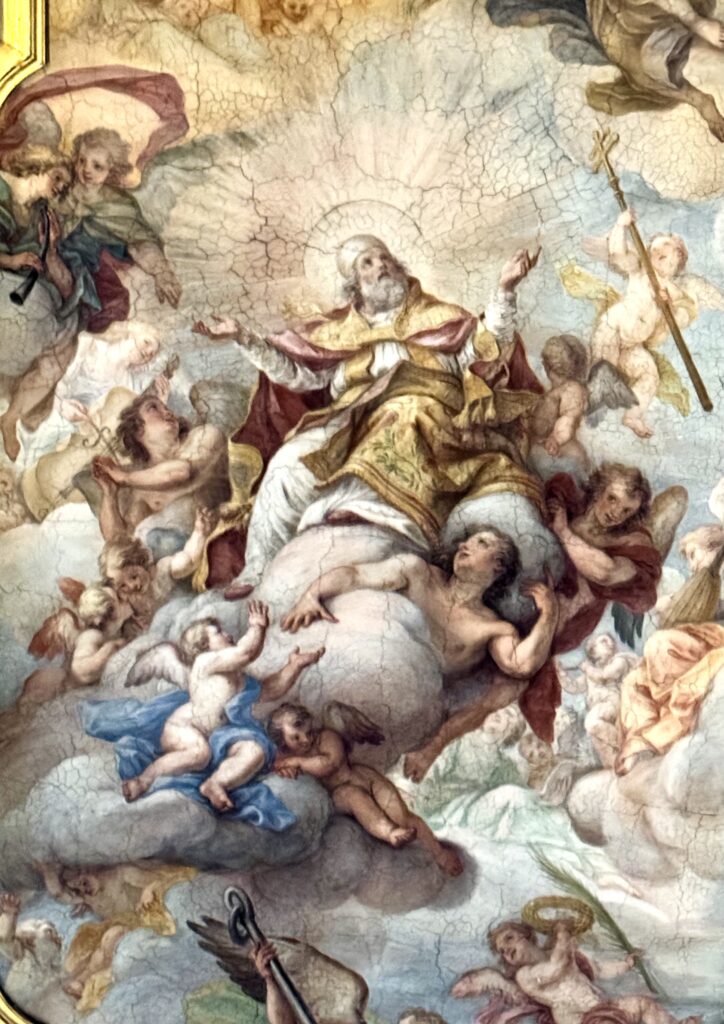
4. Rococo Ceiling
The rather exuberant ceiling is Rococo in design, not my favorite architectural style. It was designed at the beginning of the 18th century by architect Carlo Stefano Fontana.
The ceiling is made of wood and gold. It’s decorated with papal symbols like doves, palm leaves, and stars. There’s a carving of the coat of arms of Pope Clement XI.
In the middle is a painting by Giuseppe Chiari, The Glory of Saint Clement. The saint is lifted up to heaven by angels.
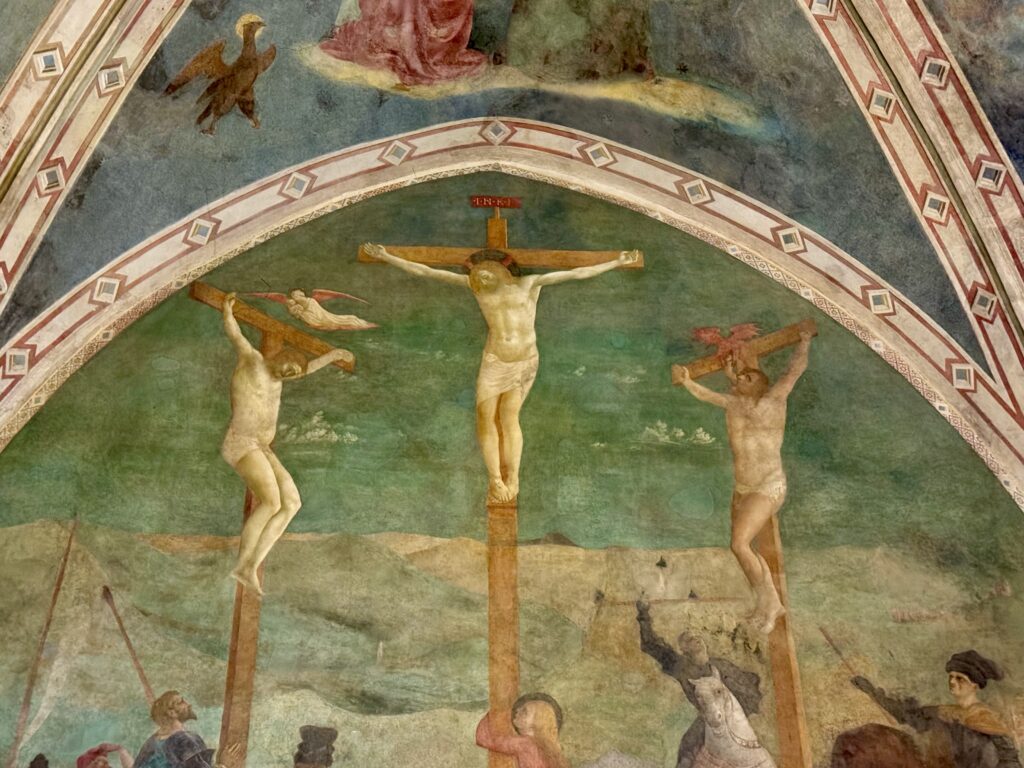
5. Castiglione Chapel
There are some beautiful and important 15th century frescos in this chapel, on the left hand aisle. It’s worth a visit to San Clemente just to see them.
For a time, it was thought that the famous Masaccio was the painter. But today they’re attributed to Masaccio’s teacher, Masolino da Panicale.
Masolino painted them about three years after Filippo Brunelleschi’s development in Florence of single point perspective system. The frescos thus represent a key bridge between medieval art and Renaissance art.
The patron of the chapel was Cardinal Branda da Castiglione. This type of fresco is usually seen in Florence. It’s a rare early Renaissance painting in Rome.
You see an annunciation on the top, with the angel Gabriel and Mary in an enclosed architectural space (with imperfect linear perspective).
In the crucifixion fresco, there’s a triple execution (again more commonly found in Florence). The good and bad thieves flank Christ. A demon pulls the soul out of the bad thief. Below is the customary melee.
The frescos aren’t in the greatest condition. They’re painted on an exterior wall, and hence were subject to humidity.
On the side, you see better preserved frescos of scenes from the life of St. Catherine of Alexander. Catherine converted to Christianity and successfully converted others. This pissed off the anti-Christian Emperor Maxentius, the predecessor of Constantine.
There’s an image of Catherine debating 50 of Maxentius’s orators. Not only did she defeat them in the debate, but she converted them as well.
Maxentius then tried to kill her with a spiked wheel, but she was miraculously saved by an angel. Maxentius then resorted to a more simple beheading.
In another part of the chapel, you see scenes from the life of St. Ambrose. He was a brainiac and bishop of Milan. Castiglione wanted to celebrate intellectualism.
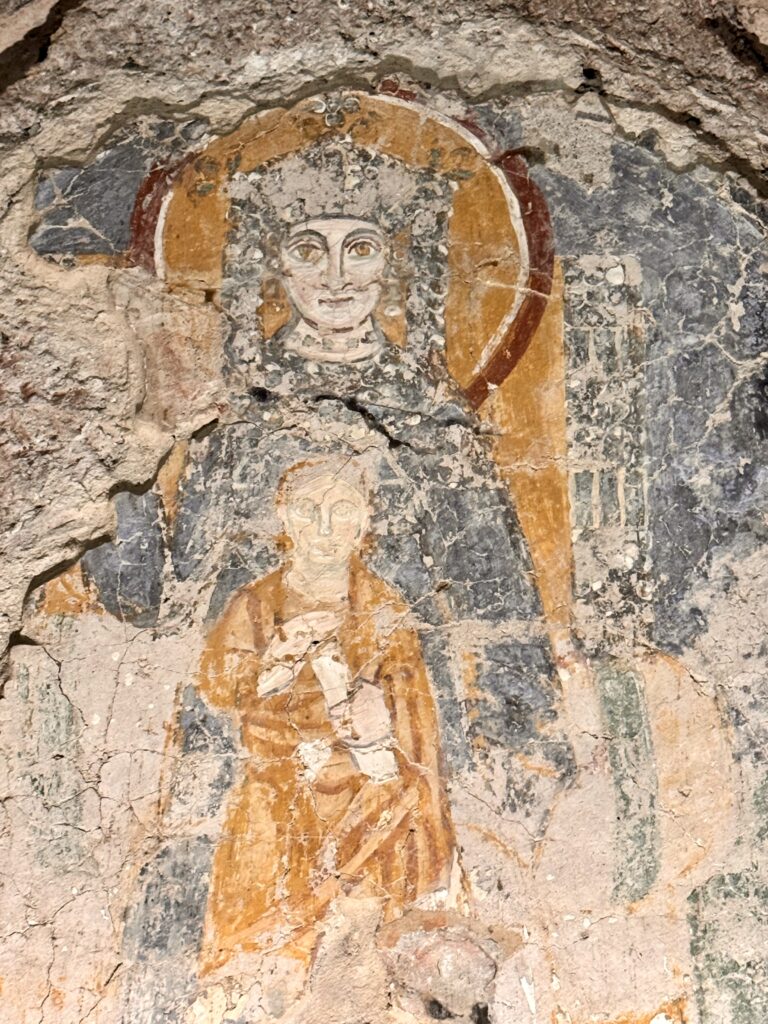
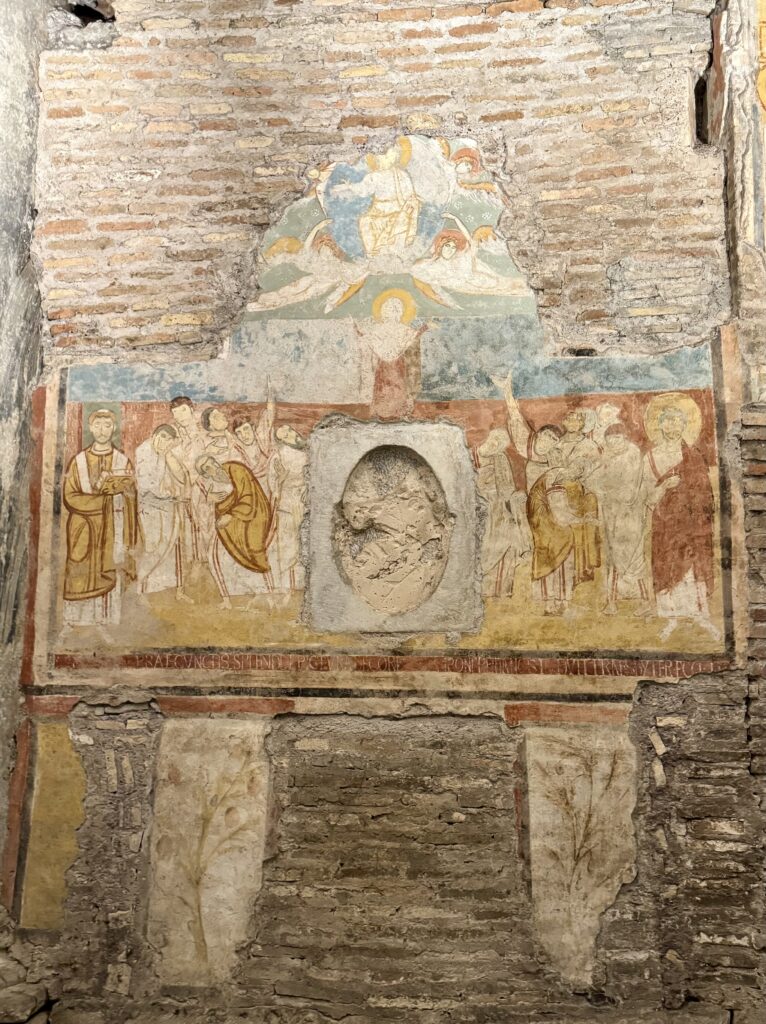
6. 4th Century Church and Frescos
The Basilica of San Clemente is just the proverbial tip of the iceberg. Beneath the basilica lie two more levels. The second level is a 4th century early Christian church. It was mostly demolished, becaming the foundation of the 12th century basilica.
The old basilica was discovered in 1857. A Dominican friar began excavations hoping to find the house of Saint Clement, who by legend lived underneath the new church. But what he found instead was another basilica.
You have to pay to go down to the spooky subterranean setting. Definitely do it. There’s a ticket booth off to the right. You head down the stairs into utter silence, feeling like you’re Indiana Jones.
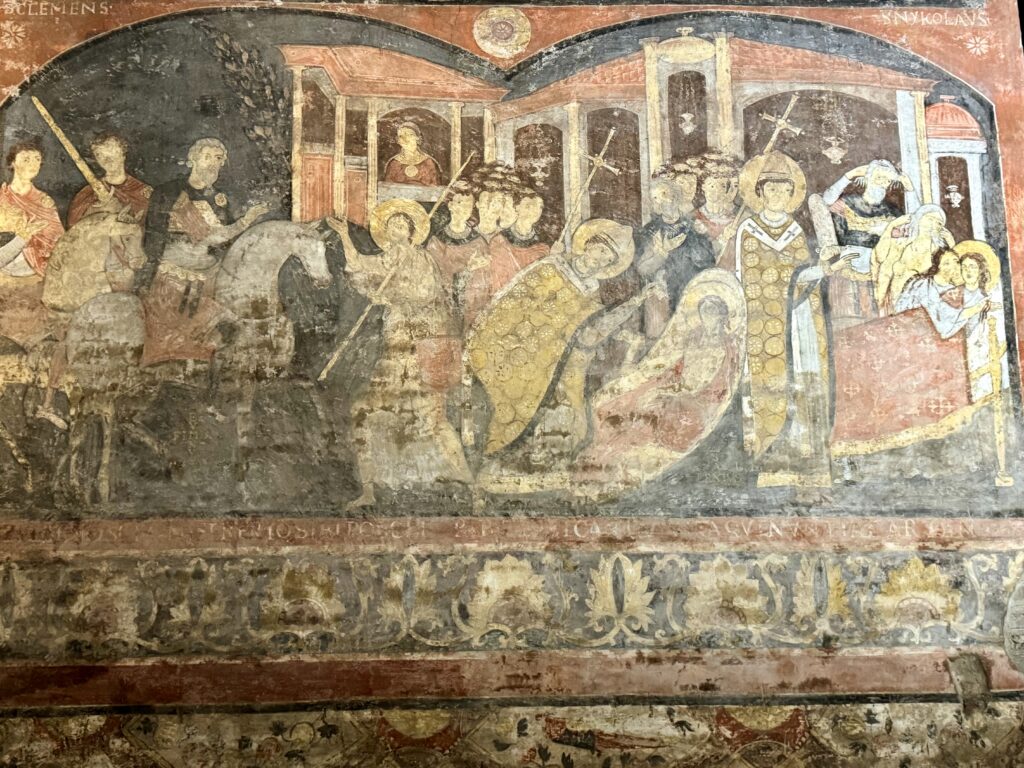
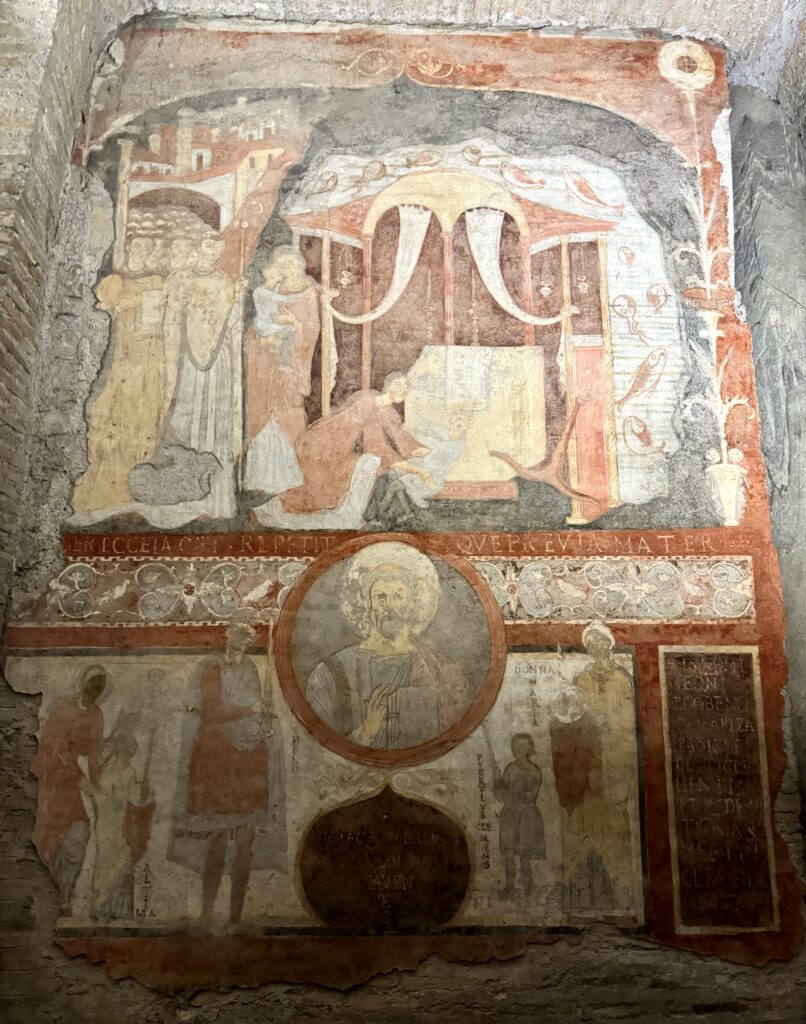
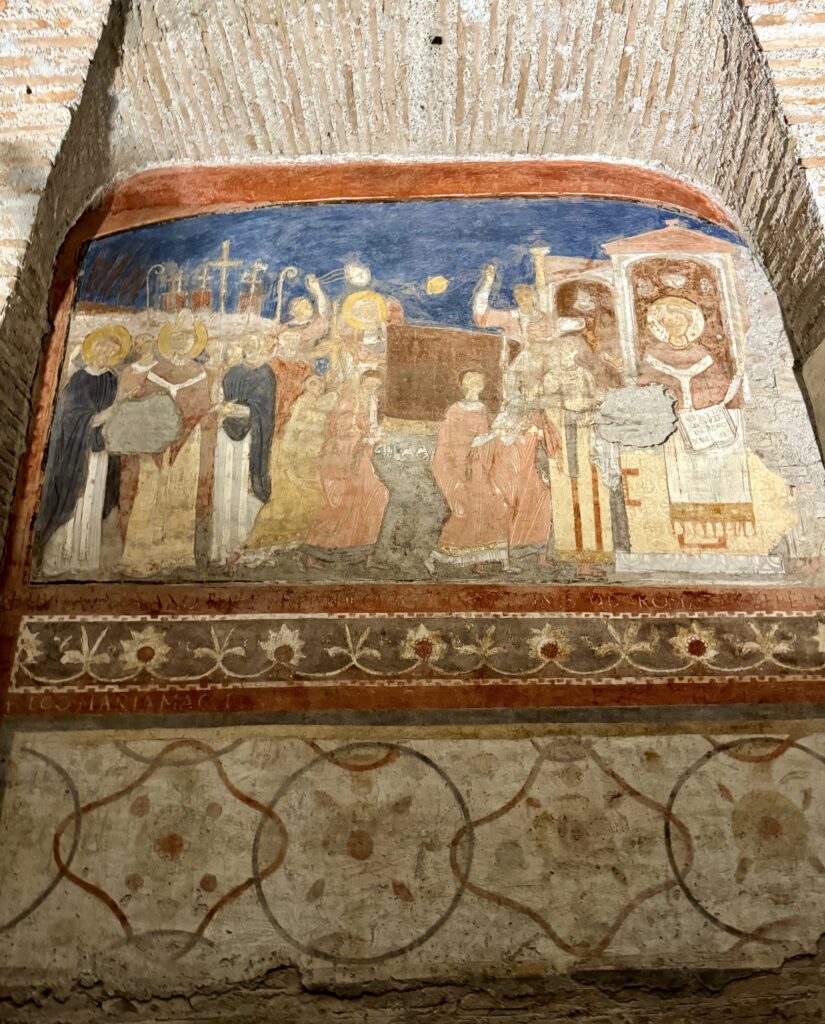
The 4th church is somewhat cramped and fragmentary. Modern buttresses support the medieval church above and reduce the height of the ceiling. It’s as if you’re in a tunnel.
But significant effort went into clearing this space. The excavation revealed once buried artworks, previously consigned to oblivion.
You’ll see remnants of extremely rare early Christian frescos. Some were dedicated to the life of Saint Alexis.
There’s also a pagan sarcophagus from the 2nd to 3rd century, depicting the mythological story of Phaedra and Hippolytus. And the tomb of Saint Cyril.
Never head of that Saint Alexis? He was popular in early Christianity. He was a nobleman who gave up a life of wealth to life as an ascetic, much like Saint Francis.
You’ll also see scenes from the life of Saint Clement himself. According to the Bible, one of his devotees was a married woman.
Her husband of course grew suspicious. He followed her around in boisterous violence. Clement casts a magic spell to prevent being murdered by the husband’s servants.
There’s also an altar and baldachin on this level. You’ll see an anchor on it, which is the symbol of Saint Clement.
Why an anchor? It’s because Saint Clement was martyred by being tied to an anchor and thrown into the Black Sea.
7. Mithraic Temple
The best is even further below. Walk through another unmarked door and descend further. The temperature drops more.
The most exceptional and mysterious part of San Clemente is here — the perfectly preserved 3rd century Mithraic temple. A Mithraic temple is is a temple to the obscure and messianic Christ-like god Mithras.
In ancient Rome, there were a fair number of cults. This was partly due to soldiers coming back from far afield with new religious ideas.
READ: Guide To The London Mithraeum
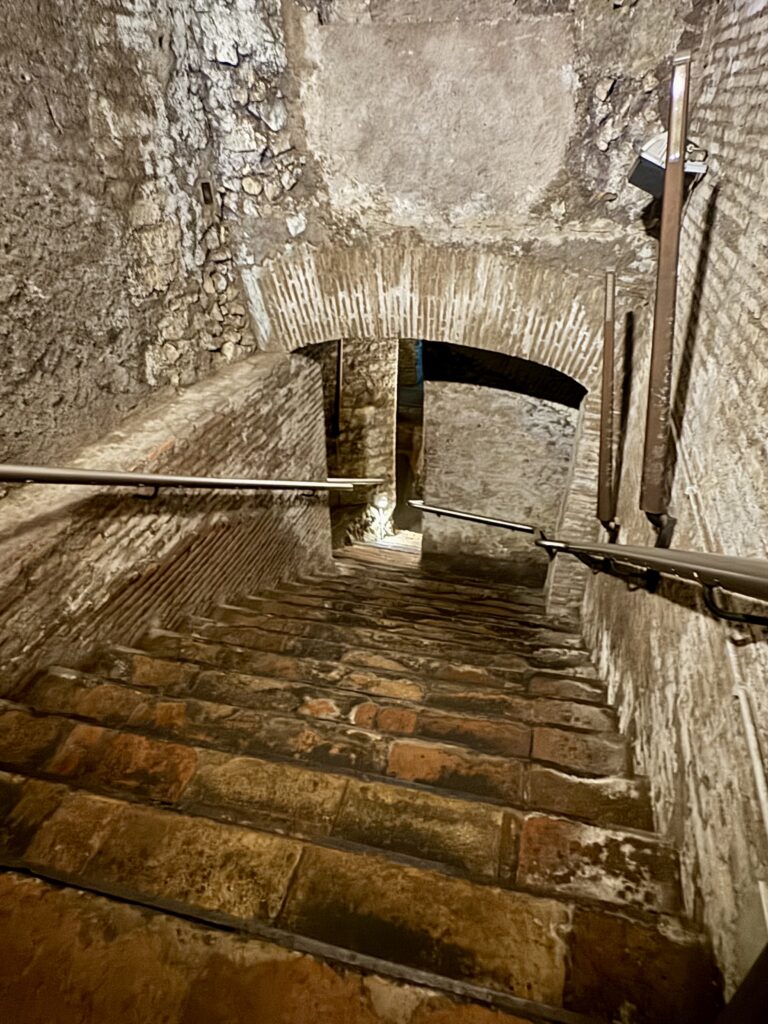
Mirthras wasn’t a deity from the Greco-Roman canon. Mirthraism is Persian in origin, from the Zoroastrian god Mithra.
More than half a dozen Mithraea have been discovered in Rome itself and 100 in Europe. The extant temples suggest that the cult of Mithras was popular and a rival to Christianity.
Mithraism shared some features with Christianity. Mithras delivered salvation to mankind and emphasized morality. But the cult was more exclusive.
Mirthraism’s devotees were exclusively male and mostly soldiers, who embraced a rigid code of obedience. By the 4th century, the new official state religion of Christianity crushed the cult and its swelling number of adherents.
The Mithraeum in San Clemente is cave-like. It has a central altar and is surrounded by benches, where followers would sprawl out.
Around 200 AD, a nobleman living on this very spot converted what was the central room of his house into a Mithraeum for secret worship.
A niche was created out of the doorway at the western end of the room, to hold the cult image. Stone benches were constructed along either side of the room. Devotees would have reclined here for the ritual feast.
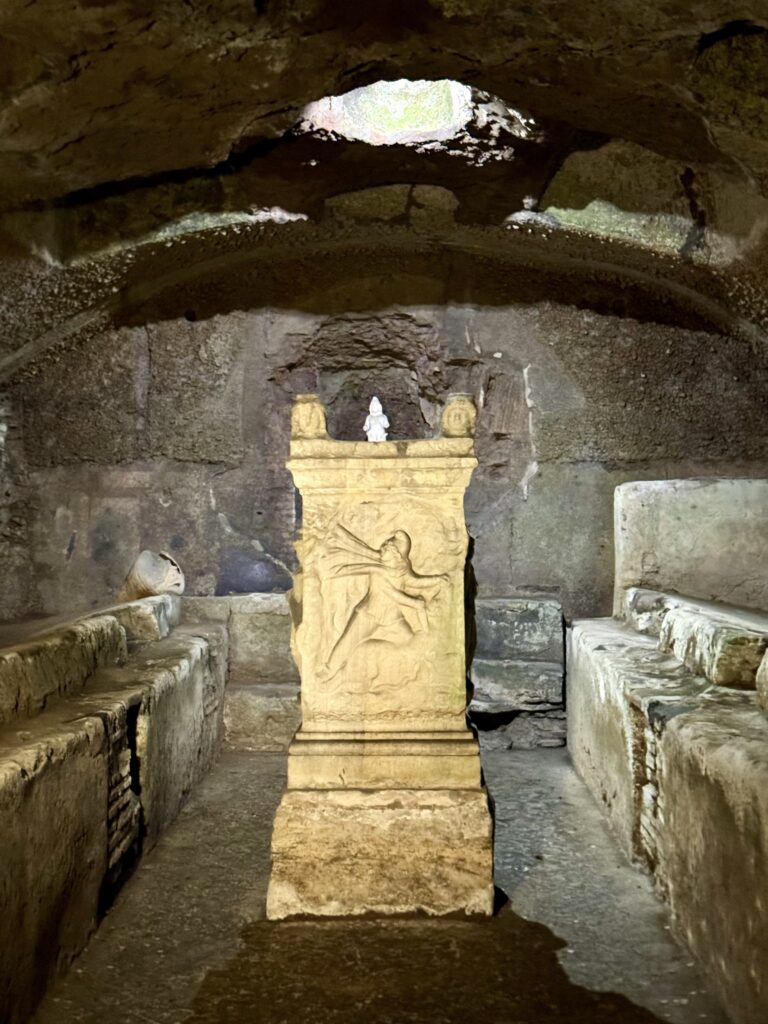
Between these two benches and in front of the niche would have stood the altar of Mithras. Today, a replica cast stands in its place. You see a relief of Mithras slaying a bull with a knife.
Continuing past the temple and taking a left, there’s a skinny 2,000 year old Roman alley that divides the temple and the mansion. Straight ahead past the alley entrance is the entrance to the mansion.
It was the home of Titus Flavius Clemens. On the right (sometimes closed) are two of the best preserved rooms, with beautiful Roman brickwork. At the very bottom runs a river. Visitor’s can throw coins in for good luck.
Practical Guide & Tips For San Clemente
Address: Via Labicana 95
Hours: Monday to Saturday 9:00 an to12:30 pm & 3:00 pm to 6:00 pm. Sundays and state holidays 12:15 am to 6:00 pm
Entry fee: The basilica is free. Entrance to the subterranean levels, via a 30 minute self guided tour, is €10 (online) or €12 (in person). Click here to buy your ticket online.
Pro tips: You can’t bring bags inside. Dress modestly.
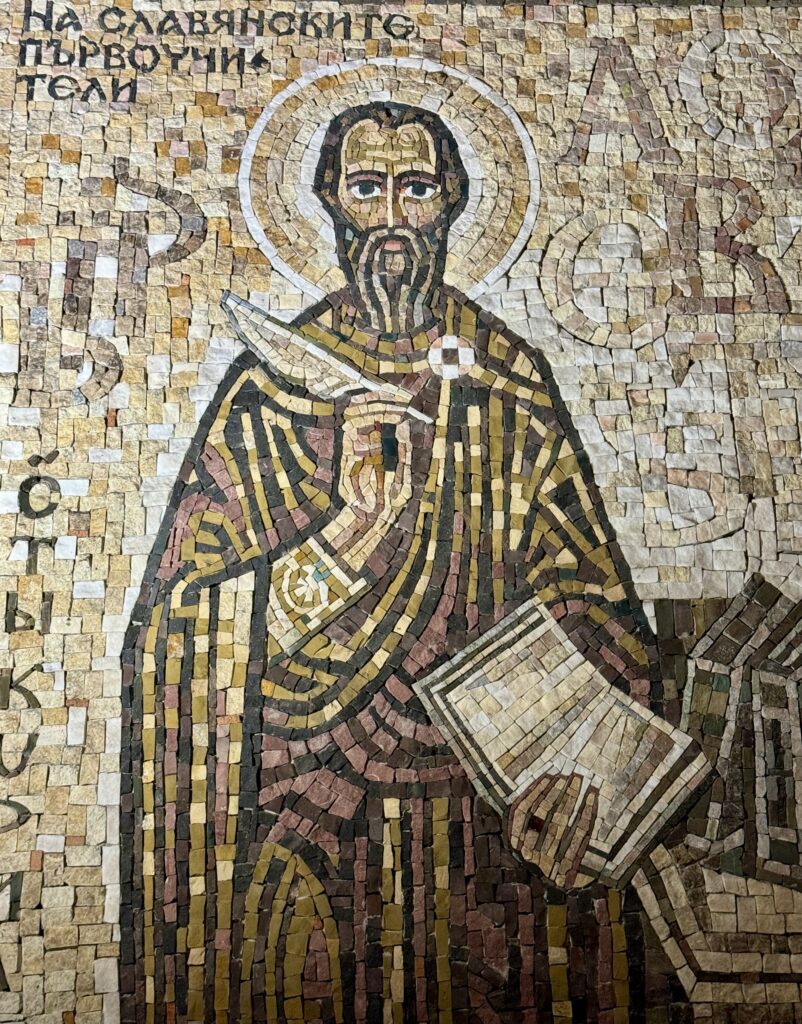
I hope you’ve enjoyed my guide to the treasures of the Basilica of San Clemente. You may enjoy these other Rome travel guides and resources:
- 3 day itinerary for Rome
- 5 day itinerary for Rome
- Hidden gems in Rome
- Best museums in Rome
- Archaeological sites in Rome
- Guide to the Borghese Gallery
- Guide to the Capitoline Museums
- Guide to Palatine Hill
- Guide to the Roman Forum
- Guide to the Colosseum
If you’d like to visit San Clemente in Rome, pin it for later.

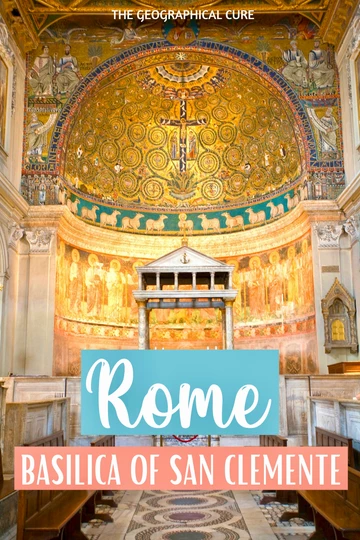
Hello Leslie,
Great article. One minor nitpick. In the apse mosaic in the Basilica of San Clemente, the four figures dressed in black and white are not Dominicans. Those figures are original to the 12th century mosaic. In very small writing each is identified. They are the four original doctors of the Latin church, Augustine, Jerome, Gregory the Great and Ambrose.
Cheers!
Kevin
Portland, Oregon
Thanks Kevin!